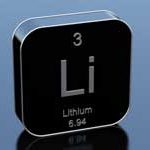Management Team
Markets
LITHIUM METAL

Lithium is a chemical element with symbol Li and atomic number 3. It is a soft, silver-white metal belonging to the alkali metal group of chemical elements. Under standard conditions it is the lightest metal and the least dense solid element. Like all alkali metals, Lithium is highly reactive and flammable.
Mineralogy
Lithium never occurs freely in nature, but only in compounds, such as pegmatitic minerals which are one of the main sources of Lithium. Due to its solubility as an ion, it is present in ocean water and is commonly obtained from brines/salars. The principal ore minerals of economic interest in hard rock deposits are spodumene and lepidolite.
A new source of Lithium can now be added to this list, that of Lithium-enriched micas formed in schists of country rock subject of intrusion by leucogranites. A white mica and zinnwaldite are the common forms.
Uses of Lithium
Many uses have been found for Lithium and its compounds. Lithium has the highest specific heat of any solid element and is used in heat transfer applications. It is used to make special glasses and ceramics, including the Mount Palomar telescope’s 200-inch mirror. Lithium is the lightest known metal and can be alloyed with aluminium, copper, manganese, and cadmium to make strong, lightweight metals for aircraft. Lithium hydroxide (LiOH) is used to remove carbon dioxide from the atmosphere of spacecraft. Lithium stearate (LiC18H35O2) is used as a general purpose and high temperature lubricant. Lithium carbonate (Li2CO3) is used as a drug to treat manic depression disorder and for battery manufacture.
Market Outlook
The following is an extract from an article by Roger Montgomery (founder and chief investment officer at Montgomery Investment Management) in the Weekend Australian dated May 1-2, 2021:
“According to Roskill Information Services, in 2017, 48 per cent of the global market for lithium products was estimated to be based on batteries. As demand surges it will also put pressure on the demand for lithium by ceramics, glass, lubricating grease, polymer, continuous casting mould flux powder and agrichemical manufacturers.
According to Roskill’s June 2020 forecast, Li-ion battery demand will increase more than ten-fold by 2029, reaching in excess of 1800GWh capacity. The pipeline capacity of battery gigafactories is reported by Roskill to exceed 2000GWh in 2029, at more than 145 facilities globally. But that forecast was made nearly a year ago.
Today, it is reported 180 gigafactories alone either exist or are under construction, and a calculation of demand planned by major battery and automotive entities suggests capacity of 3000GWh by 2030.
These estimates compare to the 455GWh of Li-ion battery production capacity in 2020 as reported by S&P Global Market Intelligence.
Estimates therefore are for a near seven-fold increase in the next nine years”.
